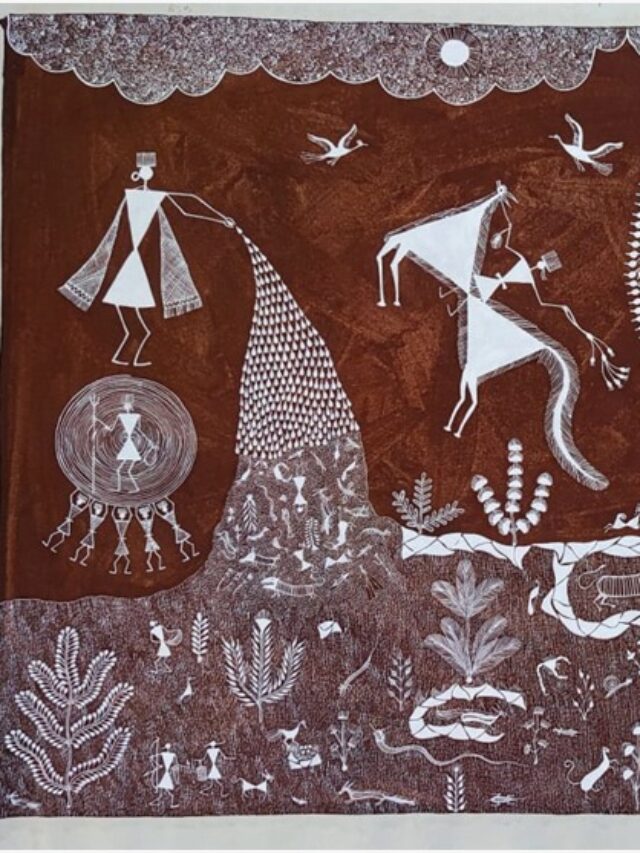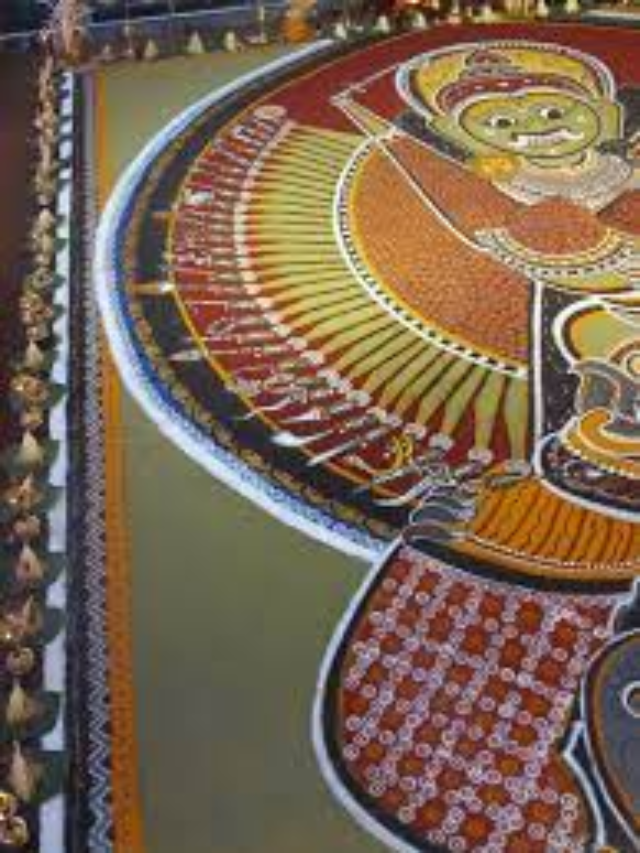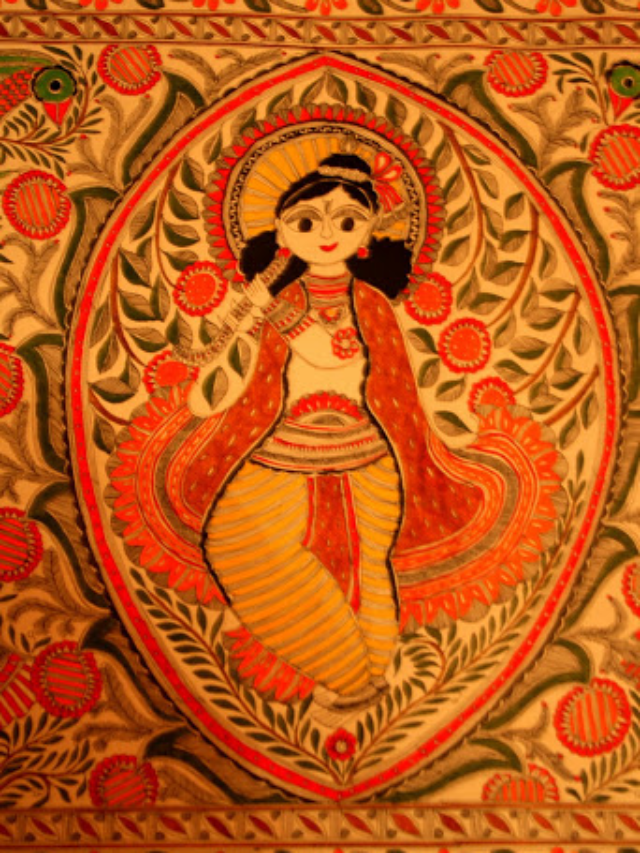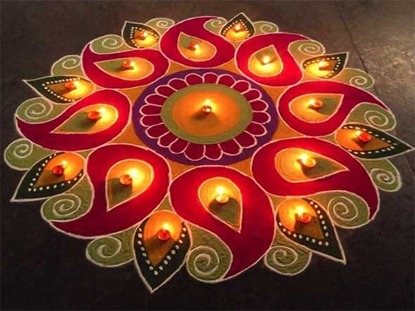What is Rangoli art? Rangoli is one of the most spectacular art forms in India. The word ‘rangoli’ is made up of two words; “rang” means “color” and “aavalli,” which means “row of colors”. It is an Indian tradition to decorate the courtyards of their households with rangoli designs on special occasions like Diwali, Tihar, Pongal, or other Hindu festivals. Finely ground white powder, along with different colors, is used to make Rangoli on the floor or walls of houses.


How Is Rangoli Originated?
When we dig deeper to find how Rangoli originated, there are a number of legends associated with it. The Chitralakshana, which is the earliest Indian treatise on paintings, has the first mention of Rangoli art. The legend is about the death of a high priest’s son, which led the kingdom into despair. The people were devastated by this death, and they prayed to Lord Brahma to bring the boy back to life. Lord Brahma was moved by their prayers, and he asked the king to draw a portrait of the boy on the floor. After that, he breathed life into the portrait, and the boy came to life again. This event brought joy and happiness to the people of that kingdom. It is believed that the first Rangoli painting was made this way.
According to another legend, one day, God, while performing one of His artistic spells, extracted juice from a mango tree to use as paint. He painted the figure of a beautiful woman with that paint. The painting was so spell-binding that the heavenly maidens were ashamed after looking at it. In this way, Rangoli became a popular practice of women’s self-portrait. Chola rulers are known to extensively decorate their floors with rangoli designs. Powder and sand are used to make rangoli, and they symbolize the impermanence of this life and Maya.
Rangoli in different parts of India.
Rangoli has different ways of making it and is called by various names in different states of India.
Rangoli is known as:
- Kolam (South India)
- Mandana is drawn on walls (Rajasthan).
- Alpana is drawn in the courtyard (Kolkata).
- Satiya (Gujrat)
- Rangoli (Karnataka)
- A Rangoli is drawn on the floor. (Maharashtra)
- Chowk Purana (Uttar Pradesh)
- Sanskara Bharati (Mharastra)
- Aripan refers to decorating the floor with various designs using flour and rice paste. (Bihar)
Rangoli art and designs and colors:
A Rangoli is made to decorate the houses, and it is thought to bring good luck, happiness, and prosperity to the houses. Each area has different designs because they reflect folklore, traditions, and customs that are unique to that particular region. Traditionally, Rangoli is made by girls and women. Rangoli art and motifs are based on nature, such as flowers, petals, peacocks, swans, trees, mangoes, creepers, etc. Even the colors used for making Rangoli are extracted from natural materials like tree barks, leaves, and indigo. However, synthetic dyes have replaced the use of natural dyes in rangoli making. The appearance of rangoli art is either flat or in a 3-D form. Designs vary from simple geometric shapes to flowers, petal shapes, or deity impressions; trees; mangoes; conch shells; fish; and animals.


The Process of Making
The material used for crafting this magnificent art is dry or wet granulated rice flour. The natural pigments used are haldi (turmeric) and sindoor (vermilion). The modern variations are vibrant blues, purples, and teals. Sand and flower petals are also used for rangoli making, which adds richness and diversity to this art. It is ideal to make rangoli on a hard base like marble floors or walls, which allows the maker to sprinkle colors with greater perfection. The colors are very fine-grained pigments like gulal and aabir. It does not matter what design you are making, just make sure of one thing: that you don’t break the line or leave gaps in between. It is believed that the gaps in the lines bring the evil spirits into the home.
Rangoli Types:
Based on the designs and patterns of the shapes in the Rangoli art, it can be divided into different types as follows:
- Free-hand rangoli
- Alpana
- Wooden rangoli
- Floating rangoli
- Flower rangoli
Free-hand rangoli:
This is the most common form of rangoli, where sand of different colors is used to make the art. It is easy to work with sand and can be easily corrected if you accidentally make a mistake while designing. Peacocks, geometrical shapes, dotted designs, or literally anything can be made by utilizing these colored sands. Just make sure that your hand is steady and does not leave gaps in the lines.


Alpana:
It is the traditional rangoli of Bengal. This rangoli usually consists of only white because the paste used to make it is wet rice flour. Nowadays, many people use white paint to draw this rangoli. If you don’t like too much colorful rangoli, then this is the way to go.


wooden rangoli:
This type of rangoli art is best for newbies because it is not complex at all. It is easy to make and requires less time and energy. During Diwali, wooden stencils can be easily found in the market. You can buy them and place them in your courtyard; they will adorn your house on this special day. You can also paint or embellish the wooden pieces with stones.


Floating Rangoli:
This type of rangoli is a sight for the eyes. It is made with diyas, flowers, and candles floating in a big bowl of water. This is the best alternative if you don’t like the traditional style of rangoli making with sand colors. All you have to do is take a big bowl, fill it with water, and place flowers, diyas, and candles in it. Follow a particular pattern to achieve a spectacular design.


Floral rangoli:
Flowers are everyone’s favorite. This rangoli is made with flowers. Choose bright, colorful flowers like roses, Dahlia, and marigold and their petal to embellish your courtyard on auspicious occasions.


Conclusion
Art has been used to express human culture and beliefs since the beginning of human civilization. Art is a form of communication. People from across cultures communicate with each other via art, images, sounds, and folklore. Art is often used to depict gods and tell the story of faith. Rangoli art is considered auspicious and it is believed to have spiritual benefits.
For more posts like this visit Tribal Handcrafts blog.






